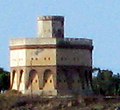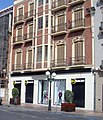| This article may be a rough translation from Spanish. It may have been generated, in whole or in part, by a computer or by a translator without dual proficiency. Please help to enhance the translation. The original article is under "español" in the "languages" list.
See this article's entry on Pages needing translation into English for discussion. (November 2024) |
| New Melilla Melilla La Nueva | |
|---|---|
| Ensanche | |
 | |
| Country | |
| Autonomous City | |
| Modernist expansion | 1901 |
New Melilla or Ensanche de Melilla is the widening of the Spanish city of Melilla that emerged in the 19th century, but especially during the 20th century.
History
From the end of the 19th century, a period of splendour began in Melilla, which created a modern city, and after Barcelona, the Spanish city with the greatest representation of modernist art, as well as the greatest representation of modernism in Africa.
There are more than a thousand listed buildings that form part of the Historic-Artistic Complex of the City of Melilla, a Bien de Interés Cultural, and are spread throughout the central expansion and its neighbourhoods. Many of them are projects by an architect from the Barcelona School based in Melilla, Enrique Nieto, who produced a very extensive modernist work, as a follower of the architect Lluis Domènech i Montaner. His floral modernist buildings stand out. Other modernist authors in Melilla were Emilio Alzugaray Goicoechea and Tomás Moreno Lázaro. In the 1930s, Art Deco took hold in Melilla's architecture, and architects such as Francisco Hernanz Martínez or Lorenzo Ros Costa created spectacular buildings in the city's neighbourhoods.
Exterior forts
They are a set of fortifications, forts not connected to each other and at a considerable distance from each other, built in the second half of the 19th century in a neo-medieval style that is rather more graceful than threatening, overflowing with a beauty that in some cases, when painted in bright colours, such as orange, makes one forget their defensive function, they seem more like elements of games and fun than defensive structures.
They are built with local stone for the walls and bricks for the arches and vaults, with obsolete fortification techniques, incapable of facing modern artillery, since the Riffian Kabyles, the enemy from which they had to defend Melilla, did not have artillery.
Historicisms
Almost all public buildings, places of worship.
-
 Church of the Sacred Heart of Jesus
Church of the Sacred Heart of Jesus
-
 Military Chapel
Military Chapel
-
 Former College of Good Counsel
Former College of Good Counsel
-
 Gaselec Building
Gaselec Building
-
 Central Mosque
Central Mosque
-
 Bombillo Fountain
Bombillo Fountain
-
 House of Crystals
House of Crystals
Eclecticisms
-
 Metropol Building
Metropol Building
-
 Grupo de Escuelas Mixtas Alfonso XIII
Grupo de Escuelas Mixtas Alfonso XIII
-
 Melilla Port Authority Building
Melilla Port Authority Building
-
 Estación sanitaria del Puerto de Melilla (Former health station of the Port of Melilla)
Estación sanitaria del Puerto de Melilla (Former health station of the Port of Melilla)
-
 Carmen Balaca's House
Carmen Balaca's House
-
 Headquarters of the Civil Society La Constructora
Headquarters of the Civil Society La Constructora
-
 Polígono Market
Polígono Market
-
 Polígono Market
Polígono Market
The eclectic is another based on mixing elements, alternating them and increasing the ornamentation, with greater richness of wrought iron and the appearance of flying cornices, highlighting Droctoveo Castañón, house of Carmen Balaca and headquarters of the North African Company and José de la Gándara, the Mixed Schools Group, current headquarters of the Department of Economy and Finance of the Autonomous City of Melilla, the Metropol building, the Melilla Port Authority building and the Polígono market.
Modernism
Enrique Nieto He is the introducer of modernism in Melilla. Although what best defines Melilla architecture is modernism, a true continuation of the Rococo, with a very rich ornamentation, of infinite and suggestive forms and varied colours.
-
 Former editorial office of El Telegrama del Rif
Former editorial office of El Telegrama del Rif
-
 Official Chamber of Commerce, Industry and Navigation
Official Chamber of Commerce, Industry and Navigation
-
 Furniture La Reconquista
Furniture La Reconquista
-
 Former Military Commissary
Former Military Commissary
-
 Former Reconquista Department Store
Former Reconquista Department Store
-
 David J. Melul House
David J. Melul House
-
 House of Jose Zea and Manuel Alvadalejo
House of Jose Zea and Manuel Alvadalejo
-
 House of Jose Garcia Alvaro
House of Jose Garcia Alvaro
-
 House of Juan Montes Hoyo
House of Juan Montes Hoyo
Emilio Alzugaray
-
 College of the Brothers of the Christian Schools
College of the Brothers of the Christian Schools
-
 House of Solomon Cohen
House of Solomon Cohen
-
 Casa de las Fieras (Melilla) (House of Beasts)
Casa de las Fieras (Melilla) (House of Beasts)
-
 House of Jose Morely
House of Jose Morely
-
 Samuel Salama's Widow's House
Samuel Salama's Widow's House
Art Deco
His masterpiece is the Monumental Cinema Sport (1930–1932).
Enrique Nieto
-
 Palace of the Assembly
Palace of the Assembly
-
 Red Building
Red Building
-
 Enrique Nieto's House
Enrique Nieto's House
-
 Carcaño's House
Carcaño's House
-
 Rafael Rico Albert's House
Rafael Rico Albert's House
-
 Real Market
Real Market
Francisco Hernanz
On the other hand, Francisco Hernanz who created zigzag works such as the House of Jacinto García Marfil, (1932), developed the aerodynamic art deco, with sober lines and almost no decoration, such as the House of Luis Raya (1935), the House of Abraham Benatar, the House of Bertila Seoane and the House of Parres.
Rationalism
Industrial architecture
-
 Mineral Bridge
Mineral Bridge
-
 CEMR Viaduct
CEMR Viaduct
-
 CEMR mineral warehouses
CEMR mineral warehouses
-
 CEMR mineral loading dock
CEMR mineral loading dock
-
 CEMR mineral loading dock
CEMR mineral loading dock
Modern architecture
Municipal Cemetery of the Immaculate Conception
It is the main cemetery of the Spanish city of Melilla. It is located in the Plaza del Cementerio, at the end of the Cañada del Agua. Its construction began in 1890, under the project of the commander of engineers Eligio Suza and contracted by Manuel Fernández, and was inaugurated on January 1, 1892, and blessed by the vicar Juan Verdejo.
Sculptural elements
-
 Monument to the Heroes of Taxdirt
Monument to the Heroes of Taxdirt
-
 Monument to the Heroes and Martyrs of the Campaigns
Monument to the Heroes and Martyrs of the Campaigns
-
 Monument to the Heroes of Spain
Monument to the Heroes of Spain
-
 Monument to Pedro de Estopiñán and Virués
Monument to Pedro de Estopiñán and Virués
-
 Statue of Legion Commander Francisco Franco Bahamonde
Statue of Legion Commander Francisco Franco Bahamonde
-
 Encuentros
Encuentros
-
 Tribute to Fernando Arrabal
Tribute to Fernando Arrabal
-
 Tribute to Melilla Modernism
Tribute to Melilla Modernism
Squares
-
 Plaza de España.
Plaza de España.
-
 Plaza Menéndez Pelayo
Plaza Menéndez Pelayo
Parks
Hernandez Park
It is the most important park in Melilla, it was built in 1902 in the shape of a trapezoid according to the design of the engineer Vicente García del Campo, and is located in the Plaza de España
Lobera Park
It is named after its founder Cándido Lobera Girela, who, as president of the Board of Arbitration, created this park to prevent the construction of barracks on his land.
Juan Carlos I Rey Forest Park
Agustin Jerez Park
References
- Bravo Nieto, Antonio (2008). Modernismo y art decó en la arquitectura de Melilla (Ediciones Bellaterra-UNED Melilla ed.). Barcelona : : Edicions Bellaterra ; UNED-Melilla. ISBN 978-84-7290-428-6. Retrieved 30 September 2024.
- Bravo Nieto, Antonio (2002). Melilla: guía histórico, artística y turística de Melilla (1a. ed.). León, España: Everest. ISBN 84-241-9300-8. Retrieved 30 September 2024.
- "Conjunto del Ensanche Modernista de Melilla". Melilla Monumental (in Spanish). Retrieved 30 September 2024.
- Costa, Tania (2 March 2023). "Fondo archivístico del mes: Memoria para el ensanche de Melilla. El nacimiento de una ciudad". El Faro de Melilla (in Spanish). Retrieved 30 September 2024.
- Gallego Aranda, Salvador (1996). Enrique Nieto en Melilla: la ciudad proyectada. Granada: Servicio de Publ. de la Univ. de Granada. ISBN 9788433822611. Retrieved 30 September 2024.
- Bravo Nieto, Antonio (1996). La construcción de una ciudad europea en el contexto norteafricano: arquitectos e ingenieros en la Melilla contemporánea (1. ed.). Melilla: Consejería de Cultura, Educación, Juventud y Deporte, Servicio de Publ. ISBN 84-87291-68-6. Retrieved 30 September 2024.
- Bravo Nieto, Antonio (1997). La ciudad de Melilla y su autores: diccionario biográfico de arquitectos e ingenieros (finales del siglo XIX y primera mitad del XX) (1. ed.). Ciudad Autónoma de Melilla: Consejería de Cultura, Educación, Juventud y Deporte, Servicio de Publicaciones. ISBN 84-87291-81-3. Retrieved 30 September 2024.
- Gallego Aranda, Salvador; Nieto, Enrique (2010). Enrique Nieto: un paseo por su arquitectura. Melilla: Fundación Melilla Ciudad Monumental. ISBN 978-84-96101-89-0. Retrieved 30 September 2024.
- "Melilla". Turismo Melilla (in Spanish). Retrieved 30 September 2024.
- "Una exposición ensalza el proyecto de ensanche de las fortificaciones de Melilla del ingeniero militar Francisco Roldán y Vizcaíno - MelillaHoy". Melilla Hoy (in Spanish). 2 October 2023. Retrieved 30 September 2024.

































